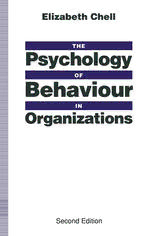
The Psychology of Behaviour in Organizations PDF
Preview The Psychology of Behaviour in Organizations
THE PSYCHOLOGY OF BEHA VIOUR IN ORGANIZA TIONS Also by Elizabeth Chell PARTICIPATION AND ORGANIZATION: A Social Psychological Approach THE ENTREPRENEURIAL PERSONALITY: Concepts, Cares and Categories (with J. M. Haworth and S. A. Brearley) THE PSYCHOLOGY OF BEHAVIOUR IN ORGANIZATIONS Second Edition Elizabeth ehell Alcan Professor of Management, School of Business Management University of Newcastle upon Tyne M © Elizabeth Chell 1987, 1993 All rights reserved. No reproduction, copy or transmission of this publication may be made without written permission. No paragraph of this publication may be reproduced, copied or transmitted save with written permission or in accordance with the provisions of the Copyright, Designs and Patents Act 1988, or under the terms of any licence permitting limited copying issued by the Copyright Licensing Agency, 90 Tottenham Court Road, London W 1P 9HE. Any person who does any unauthorised act in relation to this publication may be liable to criminal prosecution and civil claims for damages. First published 1987 by THE MACMILLAN PRESS L TD Houndmills, Basingstoke, Hampshire RG21 2XS and London Companies and representatives throughout the world ISBN 978-0-333-57001-2 ISBN 978-1-349-22939-0 (eBook) DOI 10.1007/978-1-349-22939-0 A catalogue record for this book is available from the British Library. First edition reprinted 1989, 1990 (twice), 1991 Second edition 1993 Reprinted 1994 Contents Tables Vlll Figures IX Preface to the Second Edition X I What Types of People? I The Nature of Personality Disillusionment with the Trait Concept of Personality 2 The Influence of Situations in Determining Behaviour: Interactionism 6 The Application of Interactionism to an Understanding of Work-related Behaviour 8 The Roles People Play: An Analysis of the Situation-Act Model 13 The Construction of Personality 17 Attributing the Causes of Behaviour 19 Summary 27 2 Developing People 29 Stability or Change? 29 Incremental Change: Erikson 30 Age and Change? 32 Levinson's Theory of Adult Development 34 The Search for Personal Meaning 40 Applications of the Personality Change Models to Behaviour in Organizations 44 Change and Transition 48 Organizational Constraints and Adult Development 53 Summary 56 3 Controlling People 58 Introduction 58 Understanding What Motivates People 58 How to Motivate Others 64 Fairness and lustice 70 Expectancy, Instrumentality and Valence: An Umbrella Theory 73 v vi Contents A Motivating Managerial Style 77 Summary 79 4 Working with Groups 82 Definition and Purpose of Groups 82 Types of Group 82 Group Functions 83 Group Dynamics 85 Coping with Polarization Effects 101 Summary 105 5 Team Building 107 The Importance of Team Building 107 Group and Team Development 113 Designing Management Teams 115 Other Team-building Approaches 123 Summary 126 6 Leadership 128 Introduction 128 Leadership as Quality or Process? 130 Leadership Style 134 Contingency Approaches 142 Leadership Reconsidered 152 Leadership Skills 153 Summary 155 7 What are Organizations? 158 Definitions 158 Organizational Structures 162 The Nature of Bureaucracy 164 The Open-systems Approach 173 Socio-technical Systems 175 Work Organization and the Role of the Psychologist 176 Contingency Theory 179 Summary 180 8 Developing Organizations 185 Successfully Developing Companies 185 Tackling the Problems of Change 188 Contents vii Organization Development 194 Summary 208 9 Controlling and Managing Organizations 211 Introduction 211 Scientific Management 212 Participation 214 The Technological Imperative Versus the End-user Approaches 217 Quality Control Circ1es 221 Total Quality Management 225 Control of Performance - Another Look 227 Conc1uding Remarks 230 Summary 231 Bibliography 234 Name Index 249 Subject Index 253 Tables 2.1 Summary comparison of the transformations of personality during various phases of the life span 46 3.1 A comparison of the basic need theories proposed by Maslow, Alderfer, McClelland and Herzberg 59 3.2. The assumptions underpinning Theory X and Theory Y 78 4.1 The characteristics of mechanistic and organic systems 86 4.2 An evaluation of six different decision-making techniques 104 5.1 Contrasting behaviours in effective and ineffective groups 108 5.2 Two prevailing organizational paradigms 110 5.3 The characteristics of Belbin 's eight team roles 122 6.1 Fiedler's contingency model of leadership effectiveness 145 7.1 Characteristics of organizational goals at different hierarchical levels 160 7.2 'Pure' types of involvement, commitment and power in organizations 169 7.3 A comparison between three major structural arrangements in organizations 181 8.1 General characteristics of high and low-innovating companies 187 8.2 Eight sources of organizational change problems 189 8.3 Management issues and means of resolution 192 9.1 Technology- versus end-user-centred approaches to organizational work design 218 viii Figures 1.1 Sources of stress 11 1.2 The person-situation-act model 14 2.1 Erikson' s eight stages of personality development 31 2.2 Levinson' s model of the life course 36 2.3 The six interacting systems of personality and their integration 42 2.4 Self-esteem changes during transitions 49 2.5 The transition cycle 51 3.1 The Porter-Lawler model of the process of motivation 75 6.1 The managerial grid 139 7.1 A schematic diagram of a partial organization chart 163 8.1 The 00 cube: a typology of intervention 200 8.2 A cyclical model of interpersonal conflict 205 IX
